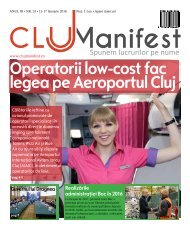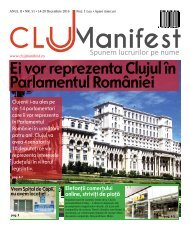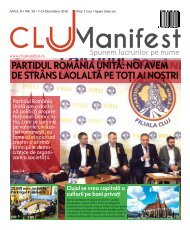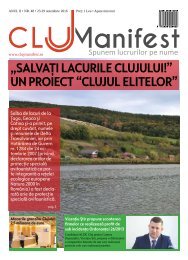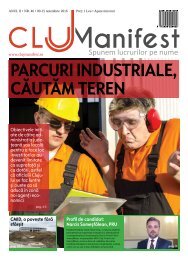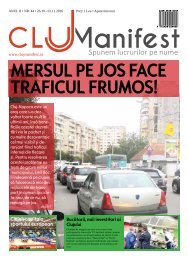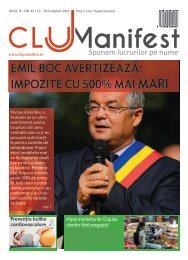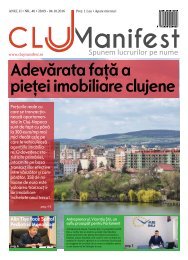ClujManifest 2016 - Numarul 14
You also want an ePaper? Increase the reach of your titles
YUMPU automatically turns print PDFs into web optimized ePapers that Google loves.
18<br />
I N T E R N A I O N A L<br />
Apare săptămânal, Miercuri<br />
Pre ‐ 1 leu<br />
THE TRUE ECONOMIC<br />
COST OF CORRUPTION<br />
IN EUROPE: UP TO €990<br />
BILLION ANNUALLY<br />
Pentru a înelege adevăratul cost economic al corupiei<br />
din Europa, Comisia europeană a comandat RAND<br />
Europe o analiză economică asupra impactului generat<br />
de corupie în statele UE. Rand Europe este un ONG,<br />
institut de cercetare a cărui misiune este de peste 20<br />
de ani a ajuta la implementarea politicilor și<br />
a mecanismelor de luare a deciziilor<br />
Pentru a înelege adevăratul cost economic<br />
al corupiei din Europa,<br />
Comisia europeană a comandat<br />
RAND Europe o analiză economică<br />
asupra impactului generat de corupie<br />
în statele UE. Rand Europe este un<br />
ONG, institut de cercetare a cărui misiune<br />
este de peste 20 de ani a ajuta la<br />
implementarea politicilor și a mecanismelor<br />
de luare a deciziilor prin<br />
analiză și cercetare.<br />
Iată un text referitor la această analiză<br />
a celor de la RAND Europe.<br />
The True Economic Cost of Corruption<br />
in Europe: Up to €990 Billion Annually<br />
by Marco Hafner and Jirka Taylor<br />
To fully understand the true economic<br />
costs of corruption within the European<br />
Union, the European Parliament<br />
commissioned RAND Europe to conduct<br />
an econometric analysis to estimate<br />
the potential harm of corruption<br />
on the EU and its member states.<br />
Our analysis resulted in a new estimate<br />
of up to €990 billion in GDP<br />
terms being lost annually, demonstrating<br />
the significant economic impact<br />
of corruption on the EU and its<br />
member states. Thatʹs more than eight<br />
times existing estimates.<br />
Prior to our ʹCost of non‐Europe Corruptionʹ<br />
study, the best estimates on<br />
the cost of corruption within the EU<br />
was at least €120 billion, which was<br />
provided by the European Commission<br />
in 20<strong>14</strong>. At the time, the former<br />
EU Home Affairs Commissioner Cecilia<br />
Malmström described the scale of<br />
corruption as “breathtaking” and<br />
even stated that the true cost was<br />
prin analiză și cercetare.<br />
“probably much higher” than €120<br />
billion.<br />
Our study also found that there are<br />
measures that can be put in place to<br />
claw back the financial losses happening<br />
each year, including monitoring of<br />
more member states, establishing a<br />
new office to assist in investigations,<br />
and implementing an EU‐wide procurement<br />
system. Together, these<br />
steps could retrieve up to €70 billion<br />
in losses annually.<br />
Corruption comes in many forms,<br />
from paying and receiving bribes, to<br />
exerting influence to provide privileged<br />
access to public services, goods<br />
or contracts. There are even examples<br />
of corruption during procurement,<br />
with contracts wrien to suit only one<br />
bidder or tenders not giving organisations<br />
enough time to respond. It is<br />
well known that corruption is associated<br />
with many societal disadvantages,<br />
from national governments<br />
having weaker rule of law to an increase<br />
in organised crime.<br />
Corruption across Europe appears to<br />
be a bigger problem than previously<br />
thought.<br />
Our new estimates considered both<br />
the indirect effects of corruption, such<br />
as disincentives of firms to invest due<br />
to corruption in EU member states,<br />
and the direct effects of corruption,<br />
such as money lost on tax revenues<br />
and public procurement.<br />
When looking at averages of three internationally<br />
recognised corruption<br />
indices, there were variations in levels<br />
of corruption across the 28 EU member<br />
states, with room for improvement<br />
everywhere, but especially in<br />
member states in Southern and Eastern<br />
Europe. A range of policy measures<br />
will be required to address this<br />
EU‐wide corruption and help to retrieve<br />
some of the money lost each<br />
year.<br />
One of these measures is applying the<br />
updated Cooperation and Verification<br />
Mechanism (CVM), which was applied<br />
to Bulgaria and Romania before<br />
they joined the EU in 2007, to other EU<br />
member states. Under CVM, both<br />
countries are subject to regular<br />
progress monitoring according to<br />
agreed benchmarks across a number<br />
of policy areas, with a particular focus<br />
on the fight against corruption. Failing<br />
to act in these policy areas can lead to<br />
a loss of privileges associated with EU<br />
membership.<br />
By contrast, the mechanism was not<br />
applied to other new member states<br />
that had joined the EU previously,<br />
such as Croatia, Latvia, Lithuania, Estonia,<br />
Slovakia, Czech Republic, Hungary<br />
and Poland. These member states<br />
were all found to have higher than average<br />
corruption levels. Seing aside<br />
practical and political considerations<br />
about its feasibility, our study showed<br />
that by applying a similar regime to<br />
additional member states, the EU<br />
could reduce corruption costs by up to<br />
€70 billion annually.<br />
Another option to help reduce the potential<br />
costs of corruption is the establishment<br />
of the European Public<br />
Prosecutorsʹ Office (EPPO). Its aim<br />
would be to help tackle corruption affecting<br />
the EUʹs financial interests, especially<br />
in areas where action by<br />
member states themselves may not be<br />
very effective. Our study showed that<br />
the establishment of the EPPO could<br />
help reduce corruption costs by €200<br />
million annually.<br />
The final measure focuses specifically<br />
on corruption involving public procurement<br />
since it is estimated to cost<br />
the EU up to €5 billion a year. To address<br />
this issue, the EU has recently<br />
adopted a set of regulations seing<br />
new rules for public procurement in<br />
Europe. The implementation of a<br />
transparent EU‐wide procurement<br />
system across all the member states<br />
could reduce corruption costs by<br />
nearly a fifth, up to €920 million annually.<br />
It would be fair to say that corruption<br />
across Europe appears to be a bigger<br />
problem than previously thought.<br />
Looking beyond the economics, tackling<br />
corruption also leads to many societal<br />
benefits: lower levels of<br />
organised crime, stronger rule of law<br />
and, as a result, more trust in public<br />
institutions.<br />
To have a properly functioning EU<br />
and member states that adhere to its<br />
values, the high levels of corruption<br />
urgently need to be addressed.<br />
_________________________________<br />
_______<br />
Marco Hafner is a research leader and<br />
senior economist at RAND Europe.<br />
Jirka Taylor is an analyst at RAND Europe.<br />
This commentary originally appeared<br />
on E!Sharp on March 22, <strong>2016</strong>.




